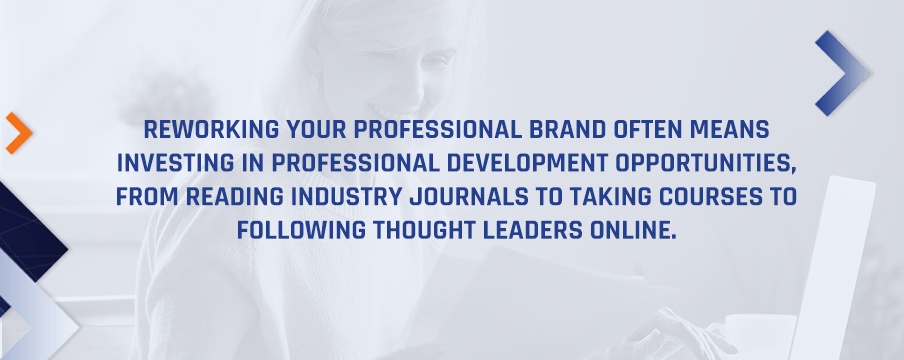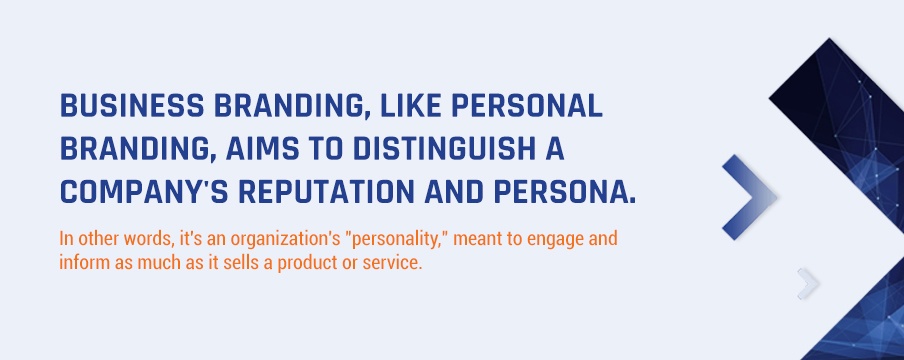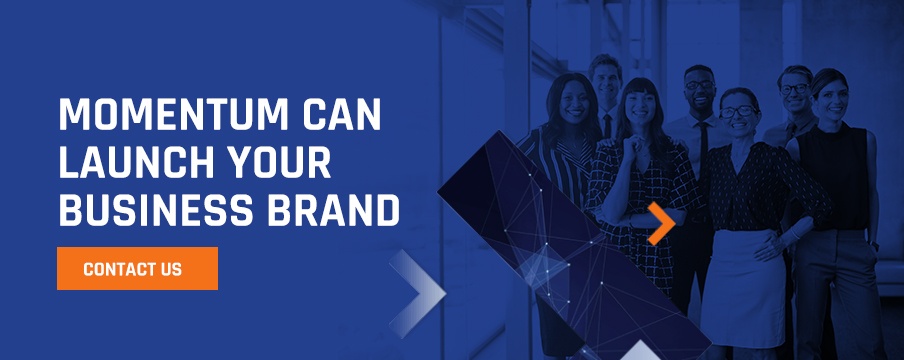Creating a Business Brand for Yourself

It’s more than the snazzy color scheme on your freshly printed business cards or the perfect headshot on your LinkedIn profile. Creating a personal brand representative of your career aspirations yet authentic to you can be deceptively tricky — particularly for young professionals or those entering a new organization or managerial role.
With our best practices, you’ll learn how to navigate personal business branding in the 21st century successfully with steps that don’t feel forced, uninspired or insincere. With that powerful personal brand, you’ll build better career confidence and identity while distinguishing yourself among your network — the ideal professional trifecta.

Why Is Having a Personal Brand Important in the 21st Century?
There are several benefits of cultivating your personal business brand, each propelling you toward a more intentional — and influential — career.
1. It Shapes Your Online Presence
LinkedIn and Facebook are near-ubiquitous ways to connect with professional contacts. Additionally, organizations use social media to research and vet potential job candidates, just as the public will use the internet to learn more about you as your influence grows. You may even turn online yourself when curious about a new colleague or after exchanging contact information with fellow conference or trade show attendees, looking to get a deeper sense of who that person is.
Crafting an intentional personal brand often begins with social media — and social media often sets ongoing impressions. The best personal business branding makes anyone who looks you up online — boss, coworker, industry colleague, freelancer, customer, client, constituent — learn what makes you tick.
2. It Gets You Noticed
Three out of every four recruiters use LinkedIn to source and vet candidates. Two out of three also use Facebook for the same recruitment purposes, driving home the importance of syncing your online and in-person presentations.
A distinct personal brand sets you apart from your colleagues online. In fact, many sites reward those who frequently post and update their profiles by making them more visible to the public, as well as those recruiters and other industry movers and shakers.
These characteristics serve you well down the road, ensuring you remain top-of-mind as a savvy, engaging and energetic professional in your field.
3. It Shapes Your Networking “Story”
Professionals with a strong business and personal brand to their names capitalize on networking opportunities organically. People with a strong sense of their professional identity understand which events to attend, who to introduce themselves to, who to follow-up with, which platforms to use and what exactly to say.
Even more importantly, they know which opportunities won’t serve their interests, working smarter — not harder — to advance their career goals. This doesn’t make them shrewd. It honors everyone’s time and practices mindful prioritization in a busy, distracting world.
4. It Makes You an Industry Thought Leader
Cultivating a personal business brand keeps you at the forefront of your industry. Those with a strong and savvy professional presentation are more likely to read, post, take professional development courses and generally stay on top of changes evolving across their fields. For example, your public branding likely keeps you informed on:
- Emerging technology poised to shake up or improve aspects of your business or organization.
- Trending markets for your industry, products or services.
- Changing industry regulations, compliance statutes and oversight.
- Evolving client or constituent tastes, including the most recent consumer studies, demographic information, social listening research and constituent surveys.
5. It Sharpens Your Skills
Reworking your professional brand often means investing in professional development opportunities, from reading industry journals to taking courses to following thought leaders online. In colloquial terms, you want to walk the walk and talk the talk, showcasing both a curiosity toward learning while sharing industry findings and knowledge with your network.
For example, someone who works in network security benefits greatly from improving their subject matter expertise across the latest in endpoint security, mobile and cloud attacks, malware, phishing schemes and other relevant topics. In sharing their own skills developments, these individuals build up a subject matter expertise brand while also improving their own resumes and acumen — a true win-win.
6. It Lets You Preempt Industry Changes
People with powerful personal brands plugged into industry developments have a better chance of forecasting changes, then responding appropriately. In certain fields defined by rapid innovation, such as software development, big data analytics and healthcare, this preemption is particularly essential, allowing players to see the upcoming skills necessary to meet tomorrow’s changing demands before falling out of the loop.
Individuals can leverage this knowledge into their own workplace roles, suggesting transformations and guiding implementation across teams, departments and offices. They become distinguished professionals at an organization more primed for success tomorrow and gain the recognition that comes with being the harbinger of positive change.
7. It’s Professionally and Personally Rewarding
Building a personal brand for yourself means taking control of your career. Both online and in person, these individuals have dedicated tremendous time and energy to identifying who they are right now as well as who they want to be — meaning their talents, interests, questions and motivations. This self-discovery creates a roadmap that guides you toward a more intentional, purposeful and focused career, the benefits of which include perks like a higher salary, higher career satisfaction, better work relationships, improved outputs and more.
Incorporating a Business Brand With Your Personal Brand
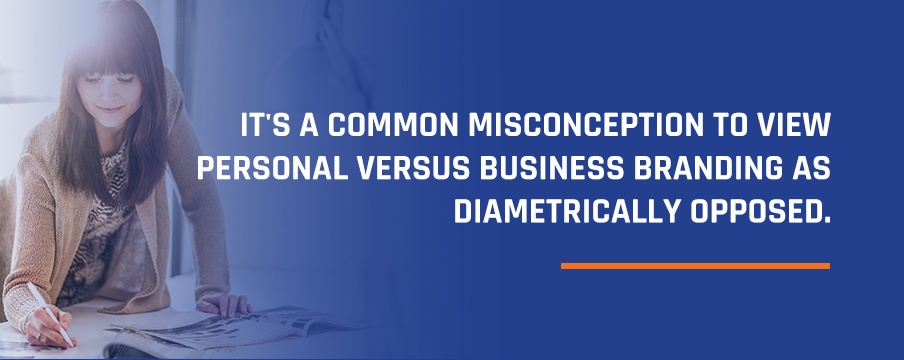
It’s a common misconception to view personal versus business branding as diametrically opposed. This couldn’t be further from the truth, particularly in today’s digital world where your online presence informs and reinforces how others view you.
How should the concepts of personal branding and business branding mix, and which needs to be emphasized for success? With modern management consulting tenets, we begin to see how.
1. What Is Personal Branding?
Personal branding is the art of creating a recognizable persona for an individual.
With personal branding, the goal is to distinguish yourself in your chosen field or niche. Like branding a product or service, it requires differentiating yourself from the competition — even subtly — while still maintaining authenticity.
Important components of a modern personal brand include:
- An origin story: Share who you are, where you come from and where you see yourself with a specific audience. People remember stories more easily than they remember facts.
- Frequent content creation: This includes live-streamed videos, Q&A sessions, hosted webinars, social media posts and more, in both written and video format.
- Consistency: Personal branding requires a scheduled commitment to online and in-person networking, not ad-hoc effort.
- Purposeful: Avoid vague, shapeless interactions or shouting into the void. Audiences will pick up on your brand faster when it maintains clear vision and intention.
2. What Is Business Branding?
Business branding, like personal branding, aims to distinguish a company’s reputation and persona. In other words, it’s an organization’s “personality,” meant to engage and inform as much as it sells a product or service.
Like a personal brand, business branding also relies on a handful of central characteristics:
- An origin story: The best business origin stories don’t focus on products or services. They center on people, especially how the business solves real people’s problems.
- A brand voice: An effective brand voice is intentionally crafted, clear and communicative of the personality embodied by your organization.
- Authenticity: Foster authenticity by purposefully departing from competitors while remaining transparent and relatable to your target audience.
3. Creating Personal and Business Brands Together
The goal of personal business branding is to deepen and propel your career by cultivating genuine industry expertise.
By fusing both traditional organizational branding with individual professional development, today’s most successful and influential industry thought leaders maintain their brand on multiple channels, namely:
- LinkedIn: The mecca for the modern-day professional, LinkedIn acts as your digital business card. Your LinkedIn profile should immediately relay who you are and what you’re professionally about, even expressing the motivations behind your field of work. Avoid using LinkedIn as a resume replica, though. It’s more than this.
- Facebook, Twitter and Instagram: Facebook, Twitter, Instagram and similar social media sites also serve a professional purpose. Thought leaders use them to share relevant videos, infographics, articles, industry commentary, thought pieces and more, each indicating clear professional interests and accomplishments. They’re also great visual mediums, letting you post photos from or during industry events, interacting with colleagues, meeting experts and more.
- Industry blog or podcast: Many individuals working on their career brands choose to manage a blog, vlog or podcast dedicated to pertinent topics and interests. Professional blogs hone key writing, critical thinking and communication skills. Yet they also amplify your subject matter expertise and can even be leveraged for public speaking and other writing opportunities.
- In person: Personal business branding means going to area networking events, setting up coffee or lunch with colleagues you admire, attending webinars, registering for skills classes, attending conferences and more — then arriving with clear goals to accomplish. These events serve as pinnacle networking opportunities to rub elbows with other motivated professionals in your field and put into practice your persona cultivated online.
Note how similar several personal and business branding’s concepts are — if not identical. This isn’t a coincidence. At its core, branding is storytelling. Personal or business branding niches are no exceptions. When merged together, personal business branding is simply its next iteration, used online and in person to relay your personality while advancing career opportunities.
Steps to Create a Powerful Business Brand
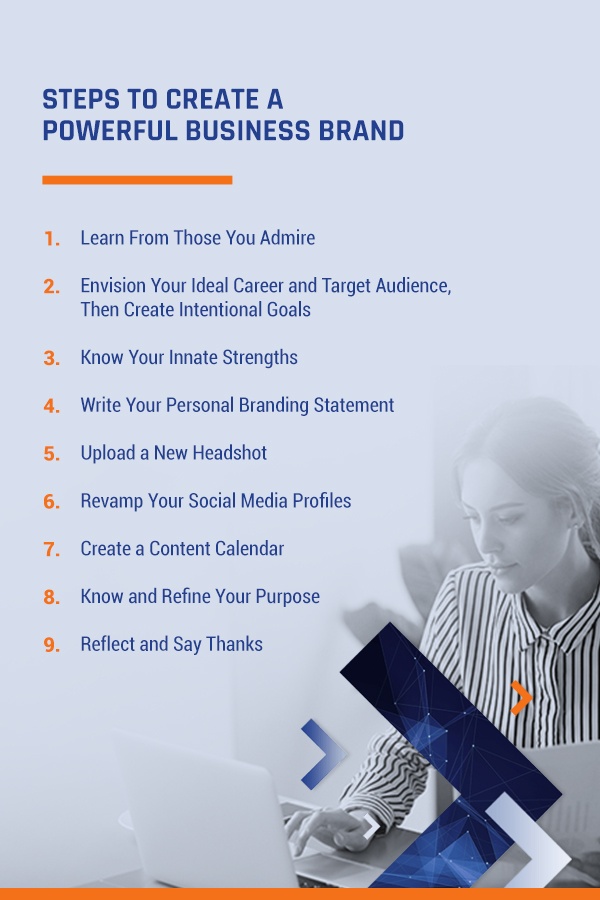
Strategize building a genuine personal brand for your career by following these steps.
1. Learn From Those You Admire
Begin your career branding journey by looking at others whose online or in-person leadership you admire.
Often, these people will be influencers in your field whose work stands out on social media, in writing across industry publications or at speaking engagements during conferences. Don’t overlook colleagues, senior management or other leaders within your organization, though. Each is mindful of presenting a specific self across their professional social media as well as in-person. Note impressive skillsets and traits,then inquire how these individuals developed them across their careers.
2. Envision Your Ideal Career and Target Audience, Then Create Intentional Goals
Having a target audience in mind helps shape your branding efforts. This parallels how most organizations, nonprofits and government agencies brand themselves, with marketing personnel shaping content always toward a specific prospect or persona. Directing your online and in-person branding strategy toward a particular audience will help focus your ideas, find the right networking opportunities and, ultimately, keep you working smarter, not harder.
It’s not all about your audience, though. Personal business branding will feel empowering when driven by an authentic purpose. Consider where you want to be professionally in the next year. Then consider the next five years. Now ten. What accomplishments do you need to check off to achieve them? Such professional development and career goals may include:
- A new title or position
- New technical skills, such as mastering Python
- Advanced degrees, such as an Information Technology Infrastructure Library (ITIL) certificate
- An increased contact list
- Increased conference, trade show and industry event attendance
- Starting a podcast or blog
- [X] number of publications to your name
- [X] number of booked speaking engagements
- [X] number of webinars hosted
- [X] subscribers to your industry blog, e-newsletter or professional courses
3. Know Your Innate Strengths
Think deeply about the unique contributions you make to your current role. What characteristics, talents and personality traits underpin those contributions? Do these traits come naturally or have you carved them strategically over time? Are others aware of these strengths in you?
Another important exercise behind business branding is to recognize what motivates you professionally. Are there specific activities, responsibilities or achievements getting you out of bed in the morning? If so, are you actively shaping your role around them, incorporating them as frequently as possible into your daily schedule? If standing out and curating a specific expertise is the end goal, you must identify these innate strengths, curiosities and motivations, then use them to your advantage.
4. Write Your Personal Branding Statement
Review your profile headline on LinkedIn. Chances are, it’s your current role title followed by your employer or city of residence.
While this headline gets the job done, it misses the larger branding opportunity: engaging your ideal audience and relaying what makes you unique in your field. In other words, your personal branding statement should convey what you do, as well as why you do it.
This type of statement is results-focused and specific, but with a dash of professional pith. It also avoids buzzword-dropping and pretentious self-promotion. Use these examples of successful LinkedIn headliners for inspiration to distinguish yourself further with your profiles and be even more recognizable.
5. Upload a New Headshot
Continue your social media polishing with an updated, high-quality headshot indicative of your newfound investment in your career.
Experts agree online headshots and profile pictures are one of the most important aspects of your professional presentation. Alongside your chosen cover photos, these images provide a visual representation of your brand’s personality. Align your image with the branding adjectives you aim to be recognized for, as well as what’s appropriate for your industry.
6. Revamp Your Social Media Profiles
Ensure other aspects of your profile stay on-par with your new headliner and profile pictures, amplifying your professional fingerprint while making it easy for your audience to find and stay connected. At a minimum, consider the following:
- Use your real name — you’re not in college anymore.
- Add industry-relevant keywords into your headliner, making it easier for recruiters and colleagues to find you.
- Geotag your city or general work location, also for recruiters and local networking purposes.
- Avoid auto-generated greetings by drafting a handful of custom “hello’s” when requesting friends or reaching out to new contacts.
7. Create a Content Calendar
Content calendars make business branding a routine, not a hobby. It ensures a disciplined approach to creating and posting content across your professional profiles, plus allots time for thinking strategically about what those posts should be instead of an ad-hoc, in-the-moment approach to sharing.
Again, look to thought leaders and influencers in your field for examples of content to post and share. Note the balance between original and third-party media, as well as the mix of static written posts, photos, videos, infographics and other content types. Most importantly, use content that fits your brand image, engages your target audience and propels your top branding goals for the month or year.
8. Know and Refine Your Purpose
Remember, neither business nor personal brands are static. As your skills and interests adapt, so will the branding niches you seek to stand out in, the information you share and the goals you revisit as you sharpen your overall brand perception.
9. Reflect and Say Thanks
Creating a relevant business brand doesn’t happen in a vacuum. Find ways to shout your thanks for all those who’ve helped you flourish in your professional endeavors. Be demonstrative in your admiration of others, give shout-outs to your network, sing the praises of your colleagues and tag people or publications that inspire you. Your gratitude will be infectious — and build a stronger, more genuine business brand.
Using Your Business Brand in the Real World

Learn the key places to leverage your evolving professional brand meaningfully — online and across everyday professional and personal interactions to forge lasting impressions.
1. Workplace Improvements and Career Advancement
In our own management consulting services, we’ve seen clients wield their burgeoning personal brand to improve office dynamics, team or work operations and — eventually — their own professional trajectory.
Much of this career advancement success comes from the confidence, contacts and learning experiences cultivated across business branding endeavors. From the colleagues you meet to the articles you read or the certificates you master, every goal in your personal branding journey can be paired with an in-the-office improvement. Consider matching yours in ways like the following:
- Building stronger teams using project management or leadership development skills.
- Negotiating improved salaries or benefits based on a new certificate or degree.
- Reworking existing jobs or roles to match current and prospective skillsets.
- Expand or improve current project workloads for yourself or your team.
2. Mentoring Programs
Another great way to leverage your powerful personal brand beyond the screen is by creating your own mentoring or educational program.
Participants who sign up receive direct tutelage from you on one of your most natural or advanced talents. Mentoring program formats and focuses are your choosing, from the technically savvy to networking skills to workplace habit or behavior improvements. Consider offering a data security course, teaching the art of mingling or providing tips on improving time management skills.
Once you’ve chosen your topic, prepare your program’s materials. Consider formats that are most convenient and relevant for your target audience, including:
- Live or recorded webinars
- Online courses
- In-person seminars or workshops
- E-newsletters
- One-on-one video or phone coaching
- And more
3. Publications
Writing on-brand content for outside publications is one of the best ways to increase your brand visibility organically. It simultaneously builds your thought-expertise public persona, as well, putting your name out there in mediums most likely to be read by your target audience, such as in:
- Popular industry blogs, websites and online forums
- Industry trade journals and periodicals
- Local newspapers
- Digital or print magazines
- Guest podcasting
- And more
Ensure everything you publish contains your contact information as well as direct links to your professional social media pages.
4. Speaking Engagements
Speaking engagements, like publishing, trigger a networking ripple effect that puts your name and face out there to be discovered.
The exposure that comes with successful public speaking aligns with several key branding goals. From driving more traffic to your blog or website to signing up more participants in your courses to a potential second income stream, booking public speaking gigs is one of the most pertinent ways to live out your personal business brand and bring it to the “real” world.
Remember these best practices when considering public speaking for your business branding goals:
- Start small, attending others’ talks or seminars and introducing yourself to the group or key speaker.
- Register for a public speaking class or hire a coach.
- Join local entrepreneurial speaking classes.
- Sign up to give speeches or keynotes for free.
- Record your talks, post them online and ask trusted colleagues and mentors for feedback.
- Gradually work your way onto bigger stages — literally — through network connections, open calls, strategic pitching and auditions.
- Move onto larger and larger event types, audiences and opportunities, growing your name and influence even further along the way.
Momentum Can Launch Your Business Brand
Momentum’s array of consulting services helps professionals in the tech, government, nonprofit sectors — and more — to stand out from the crowd and make the right impact.
Read testimonies from clients whose personal and business brands we’ve elevated, then contact us to raise your bar today.
 Tap to email
Tap to email


